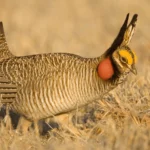
The U.S. Fish and Wildlife Service today listed the Lesser Prairie-Chicken under the Endangered Species Act. A southern subpopulation has been declared Endangered, meaning that it has been deemed in danger of extinction, while a northern subpopulation is listed as Threatened, meaning that it is likely to become Endangered in the future if circumstances do not change.
The listing comes after decades of grassland habitat loss and degradation across the species’ historic range in Colorado, Kansas, New Mexico, Oklahoma, and Texas. Lesser Prairie-Chickens are considered to be an indicator species for healthy grasslands and prairies, making their steep population decline of 90 percent since the 1800s a major concern to conservationists. Grassland birds are the most at-risk group of birds in the U.S., and have collectively declined by more than 50 percent in the past 50 years.
“It is a tragedy when a species is in such peril to warrant listing it as Endangered or Threatened under the Endangered Species Act,” said Steve Riley, Director of Farm Bill Programs for American Bird Conservancy (ABC). “The Lesser Prairie-Chicken is iconic and beloved for its unique mating ritual known as lekking. We have known for some time that listing was likely inevitable and many people have gone to great lengths to prevent the need for listing, but we are clearly losing the battle to save this species. Unfortunately, the decline of the Lesser Prairie-Chicken is a harbinger of the state of the prairies. They are being quickly lost, fragmented and degraded due to human pressures.”
“ABC has a history of working with farmers and ranchers, and in cooperation with many state and federal agencies and other partners, to address grassland habitat loss. We support proper grazing management and use of prescribed burning for grassland management,” said Jim Giocomo, ABC’s Central Region Director. “Grazing and fire are necessary to maintaining functioning grassland ecosystems.”
Giocomo continued, “We can make things get worse or get better very quickly in grasslands through our land management practices. We can choose win-win situations that provide the food, fiber, and energy we need while protecting the habitat for our imperiled species.”
###
American Bird Conservancy (ABC) takes bold action to conserve wild birds and their habitats throughout the Americas. Inspired by the wonder of birds, we achieve lasting results for the bird species most in need while also benefiting human communities, biodiversity, and the planet’s fragile climate. Our every action is underpinned by science, strengthened by partnerships, and rooted in the belief that diverse perspectives yield stronger results. Founded as a nonprofit organization in 1994, ABC remains committed to safeguarding birds for generations to come. Join us! Together, we can do more to ensure birds thrive.
Media Contact
Jordan Rutter
Director of Communications
media@abcbirds.org